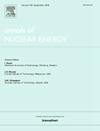了解水冷反应堆裂变产物再活化和氢风险的进展:经合组织/NEA THAI-3项目
IF 1.9
3区 工程技术
Q1 NUCLEAR SCIENCE & TECHNOLOGY
引用次数: 0
摘要
经合发组织/NEA THAI-3项目旨在调查氢气风险和来源期限问题,特别强调轻水反应堆严重事故期间预期的代表性边界条件。该项目于2016年至2019年期间进行,由德国主办,并得到了来自16个国家的签署国的支持。实验项目在技术规模的THAI+设施中进行,该设施包括两个相互连接的容器,总容积为80立方米。氢气燃烧试验研究了不同的初始流动条件、气体成分和燃烧方向对h2爆燃过程中压力积聚、火焰前缘传播和喷气点火效应的影响。其中一个氢爆燃试验(试验HD-44)作为验证燃烧模型的基准。氢气重组器(PAR)测试提供了逆流条件下重组开始、重组速率和氢气耗尽效率的数据,测试HR-49作为代码基准。源项相关实验检查了来自水池的裂变产物(CsI, I2)的再夹带,表明在表面张力降低的水池中,CsI再夹带增加了十倍。裂变产物再悬浮试验结果显示,在氢气爆燃过程中,油漆和钢铁表面的裂变产物有明显的再悬浮现象,可能在很长一段时间内仍以气体形式存在(“细颗粒”),有机碘的释放和csi -气溶胶在高温环境中分解为气态I2。本文介绍了经合组织/NEA THAI-3项目的主要发现,强调了它们在降低氢风险和核安全来源方面的重要性。总结了这些结果在轻水堆代码验证和反应堆分析方面的应用,以加强轻水堆的严重事故管理。此外,本文还讨论了通过THAI-3确定的悬而未决的问题,以及相关的实验需求。本文包含了经合组织/NEA THEMIS后续项目中解决的一些未解决问题的信息。本文章由计算机程序翻译,如有差异,请以英文原文为准。
Progress in understanding fission product remobilization and hydrogen risk in water-cooled reactors: OECD/NEA THAI-3 project
OECD/NEA THAI-3 project aimed to investigate hydrogen risk and source term issues with specific emphasis on representative boundary conditions as expected during a severe accident in light water reactors. The project was conducted between 2016 and 2019, hosted by Germany and supported by the signatories from 16 countries. The experimental program was conducted in the technical-scale THAI+ facility, comprising two interconnected vessels with a total volume of 80 m3.
The hydrogen combustion tests investigated the impact of varying initial flow conditions, gas composition, and burn direction on pressure buildup, flame front propagation, and jet-ignition effects during H2-deflagration. One of the hydrogen deflagration tests (test HD-44) served as a benchmark for validating combustion models. Hydrogen recombiner (PAR) tests provided data on the onset of recombination, recombination rate, and hydrogen depletion efficiency under counter-current flow conditions, with test HR-49 serving as a code benchmark. The source term related experiments examined the re-entrainment of fission products (CsI, I2) from water pools, showing CsI re-entrainment increased tenfold in the case of a water pool with reduced surface tension. The results of fission product resuspension tests revealed significant resuspension of fission products from paint and steel surfaces during hydrogen deflagration with the potential to remain gas-borne over a long time (“fine particles”), with notable release of organic iodine and decomposition of CsI-aerosol to gaseous I2 in the high-temperature environment.
This paper presents key findings from the OECD/NEA THAI-3 project, highlighting their importance in mitigating hydrogen risk and source term in nuclear safety. It also summarizes the application of these results for code validation and reactor analyses to enhance severe accident management in LWRs. Additionally, the paper discusses remaining open issues identified through THAI-3, along with the associated experimental needs. The paper includes information about some of these unresolved issues addressed within the follow-up OECD/NEA THEMIS project.
求助全文
通过发布文献求助,成功后即可免费获取论文全文。
去求助
来源期刊

Annals of Nuclear Energy
工程技术-核科学技术
CiteScore
4.30
自引率
21.10%
发文量
632
审稿时长
7.3 months
期刊介绍:
Annals of Nuclear Energy provides an international medium for the communication of original research, ideas and developments in all areas of the field of nuclear energy science and technology. Its scope embraces nuclear fuel reserves, fuel cycles and cost, materials, processing, system and component technology (fission only), design and optimization, direct conversion of nuclear energy sources, environmental control, reactor physics, heat transfer and fluid dynamics, structural analysis, fuel management, future developments, nuclear fuel and safety, nuclear aerosol, neutron physics, computer technology (both software and hardware), risk assessment, radioactive waste disposal and reactor thermal hydraulics. Papers submitted to Annals need to demonstrate a clear link to nuclear power generation/nuclear engineering. Papers which deal with pure nuclear physics, pure health physics, imaging, or attenuation and shielding properties of concretes and various geological materials are not within the scope of the journal. Also, papers that deal with policy or economics are not within the scope of the journal.
 求助内容:
求助内容: 应助结果提醒方式:
应助结果提醒方式:


